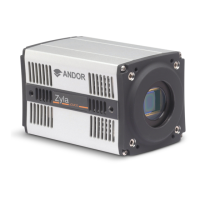version 2.0 rev 18 Feb 2021
23
2.3.1 Spurious Noise Filter
The Spurious Noise ltercorrectsforpixelsthatwouldotherwiseappearasspurious‘saltandpepper’noise
spikes in the image. The appearance of such noisy pixels is analogous to the situation of Clock Induced Charge
(CIC) noise spikes in EMCCD cameras, in that the overall noise of the sensor has been reduced to such a low
level, that the remaining small percentage of spurious, high noise pixels can become an aesthetic issue. The
lteractivelycorrectssuchhighnoisepixels,replacingthemwiththemeanvalueoftheneighbouringpixels
Theltercanbeswitchedonandobytheuserpriortodataacquisition.
Figure 11: DemonstrationofSpuriousNoiseFilter(FilterOnleft,FilterO,Right)onadarkimage,20msexposuretime,200MHz(x2
halves) readout speed
2.3.2 Blemish Correction
This Blemish Correction lteridentiesandcompensatesforthreetypesofblemishesduringtheFPGA
processing step:
1. Hot Pixel’s
2. Noisy Pixel’s
3. Unresponsive Pixel’s
sCMOS sensors are particularly susceptible to hot pixel blemishes. These are spurious noise pixels that have
signicantlyhigherdarkcurrentthantheaverage.ThroughdeepTEcoolingofthesensor(e.g.-30
o
C in the
Neo),itispossibletodramaticallyminimizetheoccurrenceofsuchhotpixelswithinthesensor,meaningthat
these pixels can still be used for useful quantitative imaging. However, if deep cooling cannot be achieved it is
necessarytouseinterpolativelterstominimizethehotpixelblemishes.Theseltersworkbytakingthemean
of the surrounding 8 pixel values and replacing this hot pixel blemish with this mean value. Such interpolation
over pixel blemishes can be detrimental in some applications that depend on total quantitative integrity over a
limitedsetofpixels,forexampleinlocalizationbasedsuper-resolutionmicroscopy(suchasPALMandSTORM
techniques)andastronomy.Intheseapplicationsitisessentialfortheusertobeabletoswitchointerpolative
corrections.
Furthermore, having access to the location of these blemishes allows an accurate map of ‘good’ pixels to be
determined by the user. A new service allows the end user to request a ‘hot pixel map’ of their sCMOS sensor
from Andor. This map will be generated based on the experimental conditions outlined by the end user.
From the latest general release of Andor SDK3 (version 3.7.30004) and Solis (version 4.24.30004) blemish
correctioncanbeswitchedonandobytheuser.RefertotheSDKandSolisUserGuideandhelpinformation
for instructions.

